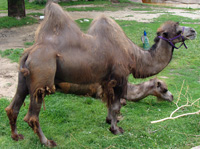Bactrian Camel Pictures
Dromedary Camel Pictures
Flying Turtle Zoo
Camel
Family Tree
Camels are in the family camelidae along with the alpaca, guanaco, llama, and vicuña. The two species of Camel are the one-humped Dromedary of western Asia and the two-humped Bactrian of central and eastern Asia.
Size and Life Expectancy
Camels are about seven feet (2.1 meters) tall (measured to the shoulder). They weigh up to 1500 lbs (700kg). They live 40 to 50 years
Range and Habitat
Camels now live in desert regions in Africa and Asia where they are almost entirely domesticated. .
Diet
Branches, leaves, shrubs, grasses.
Predators
Wolves, tigers, lions
Extra Fun Facts
Hundreds of thousands of Dromedaries run wild in Australia. They are descended from animals originally brought to work there. There are about a thousand wild Bactrian camels in the Gobi desert in China and Mongolia. Wild Bactrian camels are leaner and their humps are smaller than domesticated Bactrians. Camels can go for over a week without water and for months without food. They have been known to drink as much as 30 gallons (135 liters) of water in as little as 13 minutes. Camels do not store water in their humps! They store fat in their humps. They can run 40mph (65 km/hr) for a little while and for a long time at 25 mph (40 km/hr). People domesticated them over 3,000 years ago and they are still used for transportation across dry areas. They have many adaptations that allow them to live in the desert. They can shut their nostrils to keep sand out and they have an extra membrane that they can pull over their eye to keep sand out. Their red blood cells are oval shaped so even if they are dehydrated their blood keeps flowing. Both their feces and urine contains very little water.


